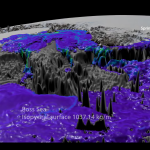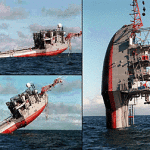People come up with all sorts of wacky ideas to explore the oceans. And here is another one of those ideas. Meet the Polar Pod, a manned research platform dreamed up by French Explorer/Physician Jean-Louis Etienne to drift around Antarctica in the Southern Ocean. My first thought when I saw this concept was WTF. But upon further inspection, I became intrigued.
Modeled after Scripp’s R/P FLIP, the Polar Pod is a floating stick with a giant weight at the bottom to keep it ballasted and upright so the living quarters that are stuck on top don’t tilt into the ocean (this FLIP don’t FLOP). When FLIP is upright, it is a super stable platform is almost completely unaffected by waves. The Polar Pod is a little different, as it has an open frame, making it more susceptible to wave action. Even so, the designers think it will still be pretty stable, only swaying as much as 5 degrees making it nearly seasickness proof. And this is perfect, because Explorer Etienne wants to set this thing adrift in the Southern Ocean, circling Antarctica via the massive current that flow around it, the Antarctic Circumpolar Current.
As I said before, I’ve been somewhat fascinated by this entire concept since I first learned about it. Mostly because it really made me think of the feasibility of such an experiment. So let’s start on a positive note, the cons of this project:
1. The Southern Ocean can be nuts. Massive winds, waves and not to mention icebergs make it a sane mariners nightmare (bah, who am I kidding. No dedicated mariner is completely sane). If they can manage to stay afloat for an entire year, then kudos to them.
2. They plan to use the platform to observe the Southern Ocean. Getting oceanographic data in the Southern Ocean is hard. The window of ‘good’ weather is small so ships don’t go there to take data during certain times of the year. But the Polar Pod will be there! And maybe what they observe will help to fill the gaps in our scientific knowledge.
3. Power. When scientists themselves aren’t exploring the Southern Ocean in ships, they are sending all sorts of autonomous oceanographic robots down there to explore it. But these things are run on batteries, and batteries don’t have a lot of power. Whatever instruments are mounted on these autonomous samplers need to sip power. And the number of instruments that do this are limited. But hopefully for all of those onboard, the Polar Pod will have a bigger power generator. This means MOAR POWER and MOAR INSTRUMENTS! Even fancier, you could even power satellite internet. Send all that data back to us scientists on shore and simultaneously Skype with all your friends back home.
4. Instrumentation. The underwater spar can be rigged up with all sorts of instruments. Get profiles of water velocity with high-powered ADCP current meters, sure. String of CTD’s down the side, yes please! Drop turbulence profiler off the side, OUI! And for good measure, slap a meteorological station on the top.
Now for the cons:
1. The Southern Ocean can be nuts. Who is going to rescue them if they run into trouble? And how is a freely drifting ship going to avoid ice bergs? What if hits one of those pesky ice bergs?
2. Supplies. Both food and fuel will have to resupplied via boat, which is a sort of nutty idea. From talking to people that have been on FLIP, moving anything from a small boat that is going up and down with the waves to a platform that is not moving at all is a potentially stupid dangerous situation. I can’t even imagine what it would be like in the Southern Ocean swell. But from what I can gather, is seems as though everything will be done by winch from the ends of it’s wings, which may make it a lot easier.
3. A proposed oceanographic research platform with no science plan (that I can find). Is this guy for real? You can’t tout your new multimillion euro vessel as a oceanographic research platform and have no science plan *pulls hair out in frustration*. But then again, his plan could be that this is a ship of opportunity for scientists who will then dictate what can and can’t be done.
Anyway, I am curious to see what will happen with this project. It may never materialize. But at least it got me thinking of all the expensive shit I could drop into the Southern Ocean.
For the francophones or those that just like pretty animations, the Polar Pod video.
Polar Pod from Sylvain Bergeon on Vimeo.
Source: http://www.lemonde.fr/sciences/article/2013/01/24/le-polar-pod-vaisseau-austral_1822295_1650684.html






Sounds like a scaled down version of SeaOrbiter. Why is French oceanography in particular heading in this direction?
There are so many crazy things. Let’s build one more and use it.
p.s. How much current drag you need under water to balance the wind drift?
I completely forgot about SeaOrbiter! Must have purposely blocked it out…
Perhaps YOU should suggest the science plan for that thing. And drop stuff in the southern ocean…
Hmmm…that’s a good question. From what I know, FLIP with it’s solid underwater profile tends to drift with currents rather than the wind. I am not sure how much drag the Polar Pod’s open scaffolding design will have and those wings probably give it another increase it’s windage a lot.
I could definitely speak to the internal wave part of the science plan. But it’s a big enough platform that they should definitely consult with more than physical oceanographers. Lot’s of great biological and chemical sampling can be done. Maybe a good platform for air-sea interactions as well!
Two opportunities exist, off the coast of NC, with Diamond Shoals and Frying Pan towers – decommissioned light stations now in the hands of private individuals. Frying Pan (Wilmington) already has a plan in place for accepting visitors while Diamond Shoals (Hatteras) is still under development.
Thanks for the video, i’m a francophone and i’m so glad to have some contents in french to improve my understanding of your site that i follow since maybe two years now.
Your work is so good and your way to teach and to talk about sea life is really suitable.
Thanks !
I am not sure what wave heights this thing is designed to withstand, but in 1980 I went to the Southern Ocean on the French ship the Marion Dufresne, which is quite a large ship, about 440 ft long and with 7 decks above the water. It was August, and while transiting from South Africa to Bouvet we ran into several storms, one of which produced waves that were coming over the bow and crashing into the bridge windows on the 7th deck. We figured the waves were about 50 ft high. So, good luck with this design I would say! The ride could get a little rough…